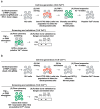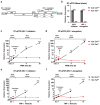HIV-1 Proviral Genome Engineering with CRISPR-Cas9 for Mechanistic Studies
- PMID: 38400062
- PMCID: PMC10892460
- DOI: 10.3390/v16020287
HIV-1 Proviral Genome Engineering with CRISPR-Cas9 for Mechanistic Studies
Abstract
HIV-1 latency remains a barrier to a functional cure because of the ability of virtually silent yet inducible proviruses within reservoir cells to transcriptionally reactivate upon cell stimulation. HIV-1 reactivation occurs through the sequential action of host transcription factors (TFs) during the "host phase" and the viral TF Tat during the "viral phase", which together facilitate the positive feedback loop required for exponential transcription, replication, and pathogenesis. The sequential action of these TFs poses a challenge to precisely delineate the contributions of the host and viral phases of the transcriptional program to guide future mechanistic and therapeutic studies. To address this limitation, we devised a genome engineering approach to mutate tat and create a genetically matched pair of Jurkat T cell clones harboring HIV-1 at the same integration site with and without Tat expression. By comparing the transcriptional profile of both clones, the transition point between the host and viral phases was defined, providing a system that enables the temporal mechanistic interrogation of HIV-1 transcription prior to and after Tat synthesis. Importantly, this CRISPR method is broadly applicable to knockout individual viral proteins or genomic regulatory elements to delineate their contributions to various aspects of the viral life cycle and ultimately may facilitate therapeutic approaches in our race towards achieving a functional cure.
Keywords: CRISPR; Cas9; HIV-1; Tat; genome engineering; transcription; viruses.
Conflict of interest statement
The authors declare no conflicts of interest.
Figures






Similar articles
-
CRISPR/Cas9 Ablation of Integrated HIV-1 Accumulates Proviral DNA Circles with Reformed Long Terminal Repeats.J Virol. 2021 Nov 9;95(23):e0135821. doi: 10.1128/JVI.01358-21. Epub 2021 Sep 22. J Virol. 2021. PMID: 34549986 Free PMC article.
-
HIV Silencing and Inducibility Are Heterogeneous and Are Affected by Factors Intrinsic to the Virus.mBio. 2019 Jun 25;10(3):e00188-19. doi: 10.1128/mBio.00188-19. mBio. 2019. PMID: 31239371 Free PMC article.
-
Elimination of HIV-1 Genomes from Human T-lymphoid Cells by CRISPR/Cas9 Gene Editing.Sci Rep. 2016 Mar 4;6:22555. doi: 10.1038/srep22555. Sci Rep. 2016. PMID: 26939770 Free PMC article.
-
New Approaches to Multi-Parametric HIV-1 Genetics Using Multiple Displacement Amplification: Determining the What, How, and Where of the HIV-1 Reservoir.Viruses. 2021 Dec 10;13(12):2475. doi: 10.3390/v13122475. Viruses. 2021. PMID: 34960744 Free PMC article. Review.
-
CRISPR/Cas9: a tool to eradicate HIV-1.AIDS Res Ther. 2022 Dec 1;19(1):58. doi: 10.1186/s12981-022-00483-y. AIDS Res Ther. 2022. PMID: 36457057 Free PMC article. Review.
Cited by
-
The HIV-1 Transcriptional Program: From Initiation to Elongation Control.J Mol Biol. 2025 Jan 1;437(1):168690. doi: 10.1016/j.jmb.2024.168690. Epub 2024 Jun 25. J Mol Biol. 2025. PMID: 38936695 Free PMC article. Review.
-
FUBP3 enhances HIV-1 transcriptional activity and regulates immune response pathways in T cells.Mol Ther Nucleic Acids. 2025 Mar 25;36(2):102525. doi: 10.1016/j.omtn.2025.102525. eCollection 2025 Jun 10. Mol Ther Nucleic Acids. 2025. PMID: 40248217 Free PMC article.
References
-
- Kirchhoff F. Encyclopedia AIDS. Springer; New York, NY, USA: 2013. HIV life cycle: Overview.
MeSH terms
Grants and funding
LinkOut - more resources
Full Text Sources
Medical
Miscellaneous

